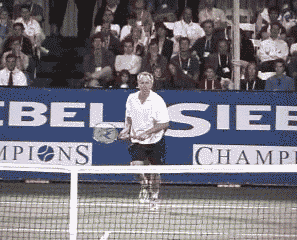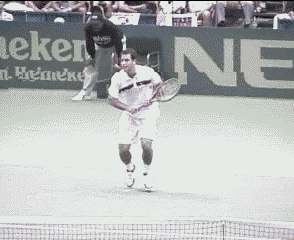|
TennisOne Lessons Effortless Volleys Daryl Fisher Do you trust your volleys? Can you consistently hit angles and place your volleys successfully? Are you able to volley with power as well as touch? If the answer to any of these questions is no, then you might have a problem with too much tension in your hands. While for some volleys hand tension could be acceptable and even useful, learning to keep your hands relaxed will be required for reaching your volleying potential. As your ability to control the tension in your hands improves, you will begin to feel how effortless your winning volleys can be. Relaxation on the Volley Is Required Hand tension is related to your ability to volley with control. Control is achieved through very subtle muscular movements in your hands and arms, and excess tension impedes your ability to make fine adjustments. The ability to make fine adjustments is what makes playing with effortless and precisely controlled power possible. (See the articles Relaxed Hands and Relaxed Hands II.)
The importance of being able to relax your hands cannot be overstated. Consider for a moment that even if you were to make no motion on your volley at all you can still get different results by simply changing the level of tension in your hands. Many players imagine their errors are due to faulty technique, but poor control of hand tension means you can hit the ball using good technique and still miss. To be clear, the previous statements are not meant to downgrade technique, but instead to note that achieving good technique is only a part of a player’s development. Tension Is Often Taught One reason you might have too much tension in your hands for your volleys is that you believed it was the right thing to do. Perhaps a tennis professional or coach even taught you to do it through very common instructions for the volley such as “firm your hand” or “firm your wrist.” While those kinds of instructions might help in some ways, the bad news is that tension is difficult to describe and convey accurately, and words such as “firm” can mean different things to different people. “Firm” almost never means “squeeze as hard as you can,” and yet many players spend their tennis lives volleying as if this definition of firm is the right one. The instruction to be firm does have some value as it is meant to help a player learn to be able to deflect an oncoming ball with the maximum amount of power as well as to make the racquet more stable. There are two dangers related to this instruction, however. One danger is that a player will only learn to use the stability provided by the tension in the hand and arm and not bother to learn the better sort of stability that is provided by good technique. The second danger of this instruction is that it might lead a player to assume that all volleys should be executed with tension in their hands, thereby preventing that person from learning the benefits of volleying with relaxed hands. How Much Tension Is Useful?
Using one level of firmness of the wrist and hand will not allow you to successfully volley with consistency. Varying the degree of firmness can be useful. People who can productively vary the tension in their hands to control their volleys are said to have good “feel,” “touch,” or “hands.” In order to utilize the oncoming power of your opponent’s shot, you should volley with a relatively firm hand and wrist. This is the best choice in order to volley deep into your opponent’s court. At other times, a short angle or drop volley may be the goal. This will generally require you to remove some of the power from your opponent’s shot. Hitting the ball with a more relaxed hand and wrist absorbs some of this power and allows you to produce a short and “soft” placement. So, to volleying with a firm hand is not wrong, but just how firm depends on the situation. There can be too much hand tension. If you actually feel effort from gripping the racquet, then it is too much tension for any situation. While it is true that to volley with more power requires firmness in the wrist and hand, that does not mean you should be gripping the racquet tightly — a very light feeling grip can still produce powerful volleys. Though these statements might seem contradictory, they are not. Firmness can be useful, but too much firmness in the form of excessive tension in the hand and wrist can lead to a loss of feel and control. Fighting Excess Tension
There are multiple potential causes for excess hand tension, so getting a proper diagnosis is the first challenge. Awareness of a problem helps considerably when it comes to finding a solution. Start with testing your technique. Examining volleying technique in detail goes beyond the scope of this article, but, interestingly, trying to relax your hands while hitting a shot is an excellent test of technique. That is, if you are able to keep your hands relaxed throughout a volley, then there is a very good likelihood that you used good technique for that shot. With few exceptions, to be able to keep your hands relaxed while hitting a stroke is a good verification that you did a long list of things correctly. For example, in order to be able to consistently keep your hands relaxed while hitting a volley, you must have a good grip (ideally the Continental grip for both the forehand and the backhand volleys) and you must make contact with the ball with your arm and racquet in a stable alignment. If you fail in either of these areas, then excess tension will almost certainly result and you will feel strain and effort in your hands, and probably in other parts of your body as well. So if you are not able to keep your hands relaxed throughout your volleys, then you might need to make some technical adjustments before you can improve your ability to relax your hands. (See the article Relaxed Hands and Good Technique or the Net Play section of the TennisOne lesson library.)
Emotional tension is also a likely potential cause of extra tension on your volley. Many players feel a great deal of stress when attacking the net. This stress can lead to extra tension, particularly in a tough match. The stress can be even worse for someone who is uncomfortable at the net. Lack of confidence in the volley perpetuates itself by creating excess tension, which thereby causes unpredictability and errors, leading to a greater lack of confidence. (See the article Overcoming the Mental Challenges of Relaxing.) Part of the cure to this challenge involves knowing that tension is a factor and then making an effort to stay relaxed. Staying relaxed is not under stressful match conditions, but if you give conscious attention to the challenge, it is an ability that can be improved. Try It! To gain an understanding of how varying levels of tension in your hands can affect your volleys, try the following drill. One player, the feeder, will hit balls from the baseline on one side of the net to another player standing near the other side of the net, the volleyer. The volleyer will have two potential targets, one very deep in the opponent’s court and one that is close to the net in the opponent’s court. While feeding a ball to the volleyer, the feeder will call out to which of the two targets the volley will be aimed, “deep” or “short.” With very little or no motion, the volleyer will then attempt to place the ball according to the feeder’s instruction. This practice drill will help the volleyer to make quick decisions, to use very little motion for the benefits of timing and disguise, and, of course, to feel the correct amount of hand tension, or firmness, required for the different shots. Try it! Your comments are welcome. Let us know what you think about Daryl Fisher's article by emailing us here at TennisOne. |

